Critical Analysis And Management Report
VerifiedAdded on 2022/09/12
|7
|1672
|34
AI Summary
Contribute Materials
Your contribution can guide someone’s learning journey. Share your
documents today.

Running head: CRITICAL ANALYSIS 1
CRITICAL ANALYSIS
Name of the student
Name of the University
Author note
CRITICAL ANALYSIS
Name of the student
Name of the University
Author note
Secure Best Marks with AI Grader
Need help grading? Try our AI Grader for instant feedback on your assignments.
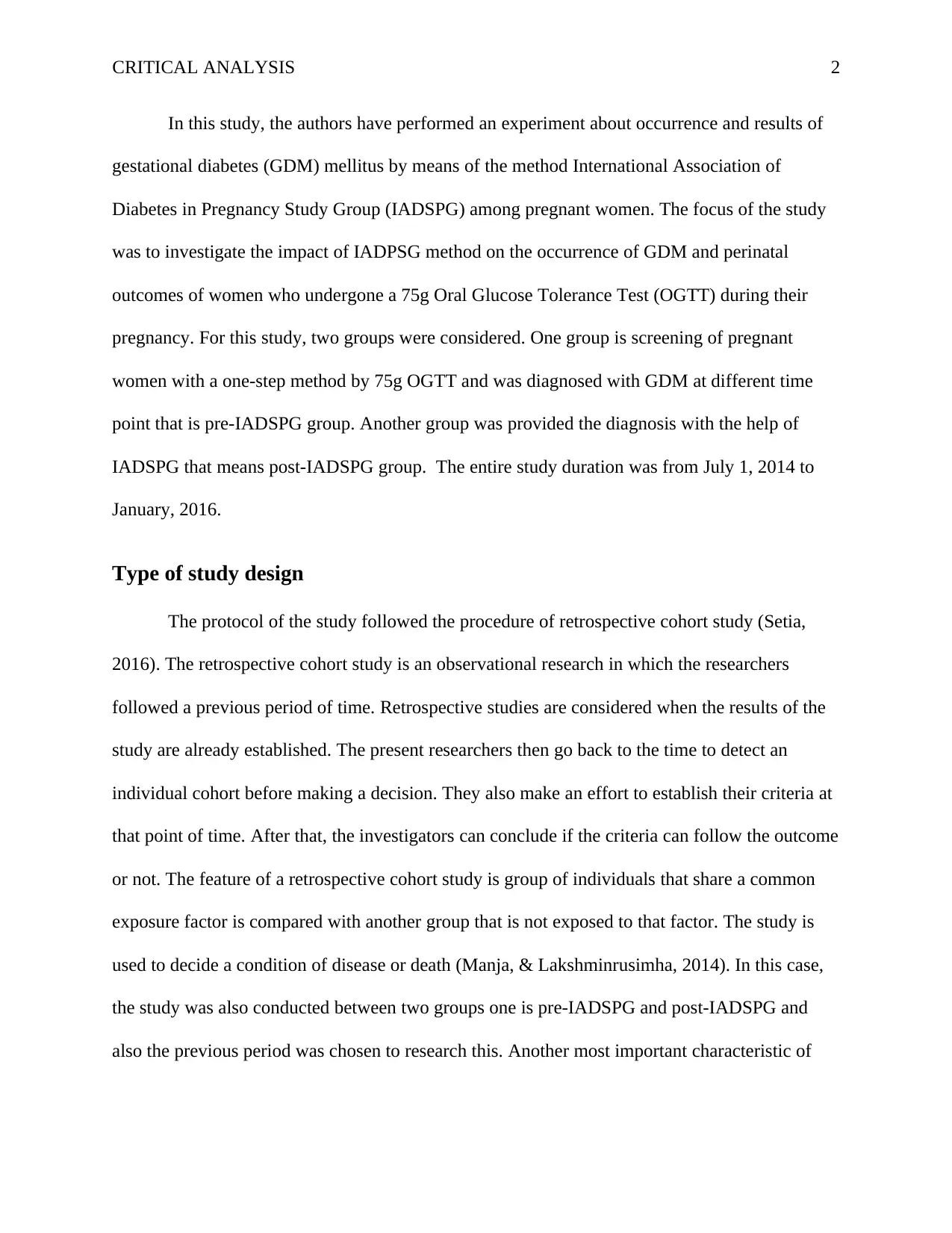
CRITICAL ANALYSIS 2
In this study, the authors have performed an experiment about occurrence and results of
gestational diabetes (GDM) mellitus by means of the method International Association of
Diabetes in Pregnancy Study Group (IADSPG) among pregnant women. The focus of the study
was to investigate the impact of IADPSG method on the occurrence of GDM and perinatal
outcomes of women who undergone a 75g Oral Glucose Tolerance Test (OGTT) during their
pregnancy. For this study, two groups were considered. One group is screening of pregnant
women with a one-step method by 75g OGTT and was diagnosed with GDM at different time
point that is pre-IADSPG group. Another group was provided the diagnosis with the help of
IADSPG that means post-IADSPG group. The entire study duration was from July 1, 2014 to
January, 2016.
Type of study design
The protocol of the study followed the procedure of retrospective cohort study (Setia,
2016). The retrospective cohort study is an observational research in which the researchers
followed a previous period of time. Retrospective studies are considered when the results of the
study are already established. The present researchers then go back to the time to detect an
individual cohort before making a decision. They also make an effort to establish their criteria at
that point of time. After that, the investigators can conclude if the criteria can follow the outcome
or not. The feature of a retrospective cohort study is group of individuals that share a common
exposure factor is compared with another group that is not exposed to that factor. The study is
used to decide a condition of disease or death (Manja, & Lakshminrusimha, 2014). In this case,
the study was also conducted between two groups one is pre-IADSPG and post-IADSPG and
also the previous period was chosen to research this. Another most important characteristic of
In this study, the authors have performed an experiment about occurrence and results of
gestational diabetes (GDM) mellitus by means of the method International Association of
Diabetes in Pregnancy Study Group (IADSPG) among pregnant women. The focus of the study
was to investigate the impact of IADPSG method on the occurrence of GDM and perinatal
outcomes of women who undergone a 75g Oral Glucose Tolerance Test (OGTT) during their
pregnancy. For this study, two groups were considered. One group is screening of pregnant
women with a one-step method by 75g OGTT and was diagnosed with GDM at different time
point that is pre-IADSPG group. Another group was provided the diagnosis with the help of
IADSPG that means post-IADSPG group. The entire study duration was from July 1, 2014 to
January, 2016.
Type of study design
The protocol of the study followed the procedure of retrospective cohort study (Setia,
2016). The retrospective cohort study is an observational research in which the researchers
followed a previous period of time. Retrospective studies are considered when the results of the
study are already established. The present researchers then go back to the time to detect an
individual cohort before making a decision. They also make an effort to establish their criteria at
that point of time. After that, the investigators can conclude if the criteria can follow the outcome
or not. The feature of a retrospective cohort study is group of individuals that share a common
exposure factor is compared with another group that is not exposed to that factor. The study is
used to decide a condition of disease or death (Manja, & Lakshminrusimha, 2014). In this case,
the study was also conducted between two groups one is pre-IADSPG and post-IADSPG and
also the previous period was chosen to research this. Another most important characteristic of
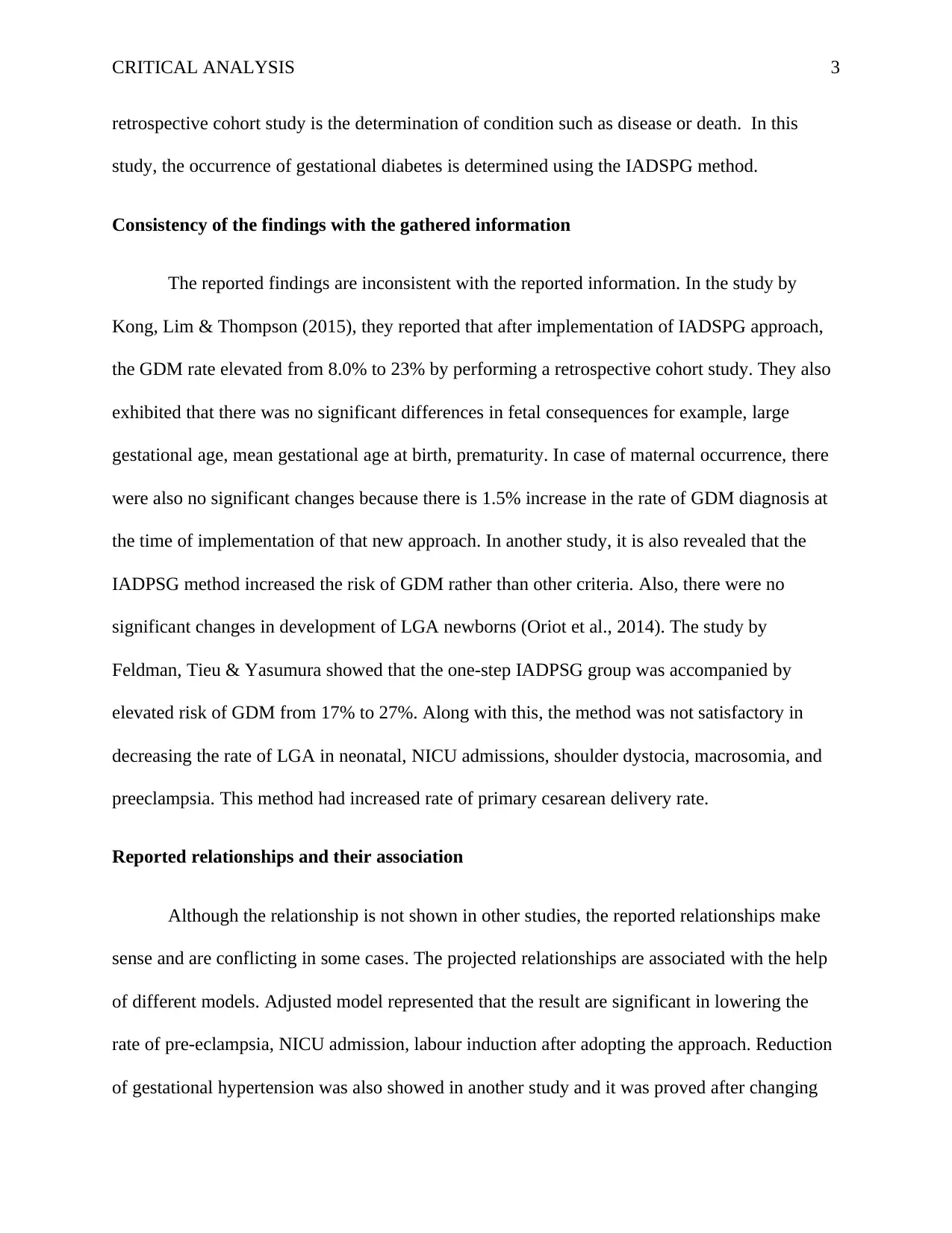
CRITICAL ANALYSIS 3
retrospective cohort study is the determination of condition such as disease or death. In this
study, the occurrence of gestational diabetes is determined using the IADSPG method.
Consistency of the findings with the gathered information
The reported findings are inconsistent with the reported information. In the study by
Kong, Lim & Thompson (2015), they reported that after implementation of IADSPG approach,
the GDM rate elevated from 8.0% to 23% by performing a retrospective cohort study. They also
exhibited that there was no significant differences in fetal consequences for example, large
gestational age, mean gestational age at birth, prematurity. In case of maternal occurrence, there
were also no significant changes because there is 1.5% increase in the rate of GDM diagnosis at
the time of implementation of that new approach. In another study, it is also revealed that the
IADPSG method increased the risk of GDM rather than other criteria. Also, there were no
significant changes in development of LGA newborns (Oriot et al., 2014). The study by
Feldman, Tieu & Yasumura showed that the one-step IADPSG group was accompanied by
elevated risk of GDM from 17% to 27%. Along with this, the method was not satisfactory in
decreasing the rate of LGA in neonatal, NICU admissions, shoulder dystocia, macrosomia, and
preeclampsia. This method had increased rate of primary cesarean delivery rate.
Reported relationships and their association
Although the relationship is not shown in other studies, the reported relationships make
sense and are conflicting in some cases. The projected relationships are associated with the help
of different models. Adjusted model represented that the result are significant in lowering the
rate of pre-eclampsia, NICU admission, labour induction after adopting the approach. Reduction
of gestational hypertension was also showed in another study and it was proved after changing
retrospective cohort study is the determination of condition such as disease or death. In this
study, the occurrence of gestational diabetes is determined using the IADSPG method.
Consistency of the findings with the gathered information
The reported findings are inconsistent with the reported information. In the study by
Kong, Lim & Thompson (2015), they reported that after implementation of IADSPG approach,
the GDM rate elevated from 8.0% to 23% by performing a retrospective cohort study. They also
exhibited that there was no significant differences in fetal consequences for example, large
gestational age, mean gestational age at birth, prematurity. In case of maternal occurrence, there
were also no significant changes because there is 1.5% increase in the rate of GDM diagnosis at
the time of implementation of that new approach. In another study, it is also revealed that the
IADPSG method increased the risk of GDM rather than other criteria. Also, there were no
significant changes in development of LGA newborns (Oriot et al., 2014). The study by
Feldman, Tieu & Yasumura showed that the one-step IADPSG group was accompanied by
elevated risk of GDM from 17% to 27%. Along with this, the method was not satisfactory in
decreasing the rate of LGA in neonatal, NICU admissions, shoulder dystocia, macrosomia, and
preeclampsia. This method had increased rate of primary cesarean delivery rate.
Reported relationships and their association
Although the relationship is not shown in other studies, the reported relationships make
sense and are conflicting in some cases. The projected relationships are associated with the help
of different models. Adjusted model represented that the result are significant in lowering the
rate of pre-eclampsia, NICU admission, labour induction after adopting the approach. Reduction
of gestational hypertension was also showed in another study and it was proved after changing
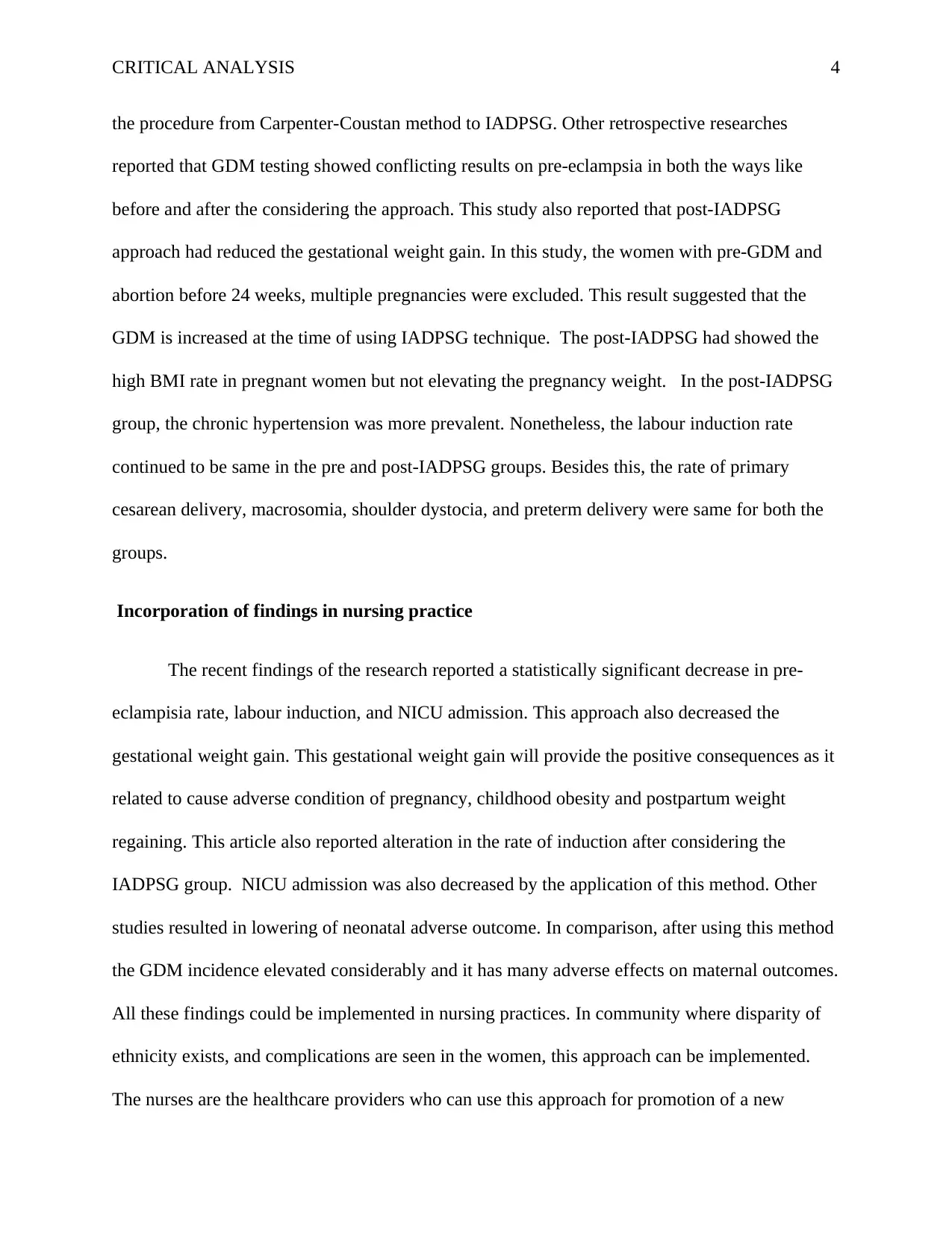
CRITICAL ANALYSIS 4
the procedure from Carpenter-Coustan method to IADPSG. Other retrospective researches
reported that GDM testing showed conflicting results on pre-eclampsia in both the ways like
before and after the considering the approach. This study also reported that post-IADPSG
approach had reduced the gestational weight gain. In this study, the women with pre-GDM and
abortion before 24 weeks, multiple pregnancies were excluded. This result suggested that the
GDM is increased at the time of using IADPSG technique. The post-IADPSG had showed the
high BMI rate in pregnant women but not elevating the pregnancy weight. In the post-IADPSG
group, the chronic hypertension was more prevalent. Nonetheless, the labour induction rate
continued to be same in the pre and post-IADPSG groups. Besides this, the rate of primary
cesarean delivery, macrosomia, shoulder dystocia, and preterm delivery were same for both the
groups.
Incorporation of findings in nursing practice
The recent findings of the research reported a statistically significant decrease in pre-
eclampisia rate, labour induction, and NICU admission. This approach also decreased the
gestational weight gain. This gestational weight gain will provide the positive consequences as it
related to cause adverse condition of pregnancy, childhood obesity and postpartum weight
regaining. This article also reported alteration in the rate of induction after considering the
IADPSG group. NICU admission was also decreased by the application of this method. Other
studies resulted in lowering of neonatal adverse outcome. In comparison, after using this method
the GDM incidence elevated considerably and it has many adverse effects on maternal outcomes.
All these findings could be implemented in nursing practices. In community where disparity of
ethnicity exists, and complications are seen in the women, this approach can be implemented.
The nurses are the healthcare providers who can use this approach for promotion of a new
the procedure from Carpenter-Coustan method to IADPSG. Other retrospective researches
reported that GDM testing showed conflicting results on pre-eclampsia in both the ways like
before and after the considering the approach. This study also reported that post-IADPSG
approach had reduced the gestational weight gain. In this study, the women with pre-GDM and
abortion before 24 weeks, multiple pregnancies were excluded. This result suggested that the
GDM is increased at the time of using IADPSG technique. The post-IADPSG had showed the
high BMI rate in pregnant women but not elevating the pregnancy weight. In the post-IADPSG
group, the chronic hypertension was more prevalent. Nonetheless, the labour induction rate
continued to be same in the pre and post-IADPSG groups. Besides this, the rate of primary
cesarean delivery, macrosomia, shoulder dystocia, and preterm delivery were same for both the
groups.
Incorporation of findings in nursing practice
The recent findings of the research reported a statistically significant decrease in pre-
eclampisia rate, labour induction, and NICU admission. This approach also decreased the
gestational weight gain. This gestational weight gain will provide the positive consequences as it
related to cause adverse condition of pregnancy, childhood obesity and postpartum weight
regaining. This article also reported alteration in the rate of induction after considering the
IADPSG group. NICU admission was also decreased by the application of this method. Other
studies resulted in lowering of neonatal adverse outcome. In comparison, after using this method
the GDM incidence elevated considerably and it has many adverse effects on maternal outcomes.
All these findings could be implemented in nursing practices. In community where disparity of
ethnicity exists, and complications are seen in the women, this approach can be implemented.
The nurses are the healthcare providers who can use this approach for promotion of a new
Secure Best Marks with AI Grader
Need help grading? Try our AI Grader for instant feedback on your assignments.
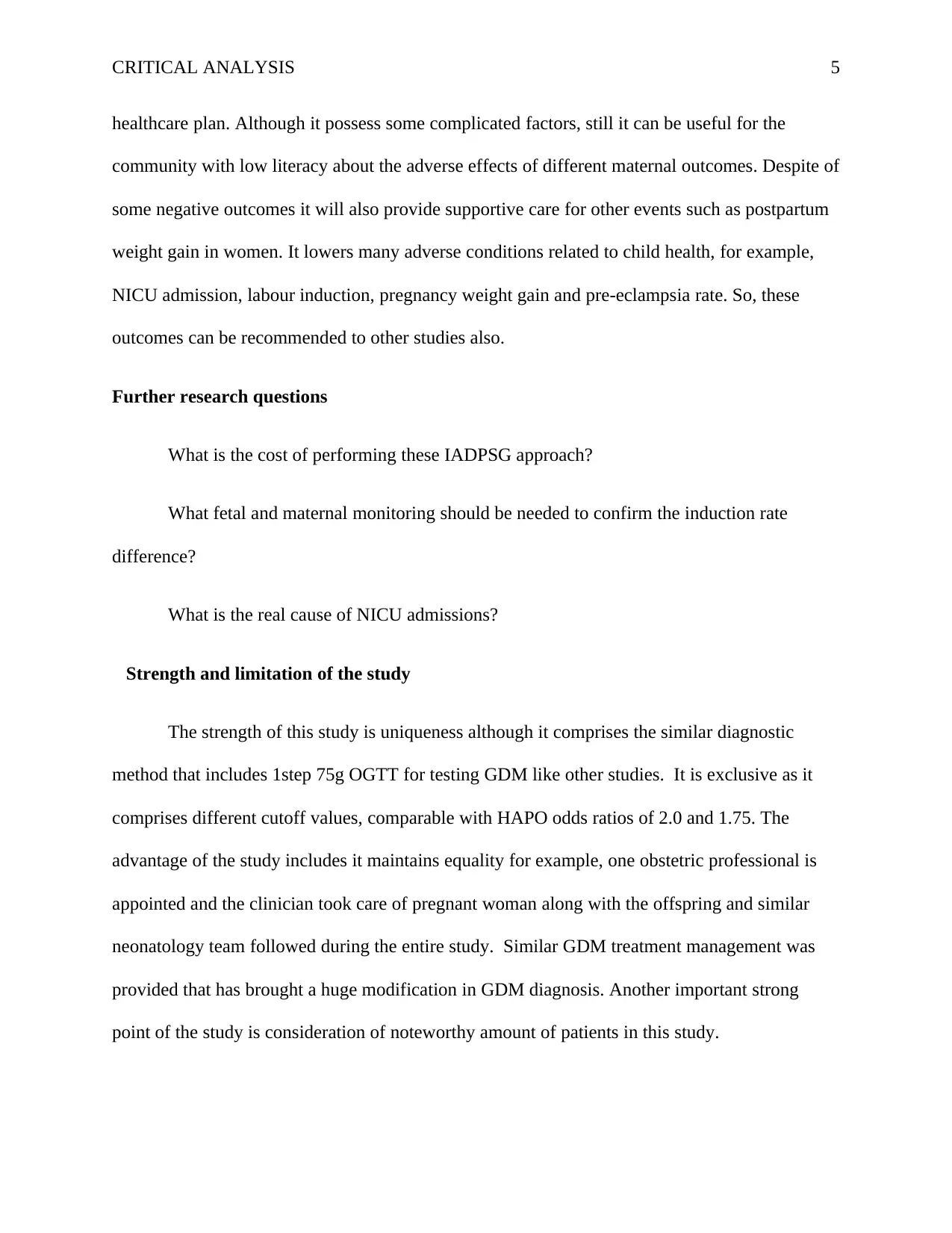
CRITICAL ANALYSIS 5
healthcare plan. Although it possess some complicated factors, still it can be useful for the
community with low literacy about the adverse effects of different maternal outcomes. Despite of
some negative outcomes it will also provide supportive care for other events such as postpartum
weight gain in women. It lowers many adverse conditions related to child health, for example,
NICU admission, labour induction, pregnancy weight gain and pre-eclampsia rate. So, these
outcomes can be recommended to other studies also.
Further research questions
What is the cost of performing these IADPSG approach?
What fetal and maternal monitoring should be needed to confirm the induction rate
difference?
What is the real cause of NICU admissions?
Strength and limitation of the study
The strength of this study is uniqueness although it comprises the similar diagnostic
method that includes 1step 75g OGTT for testing GDM like other studies. It is exclusive as it
comprises different cutoff values, comparable with HAPO odds ratios of 2.0 and 1.75. The
advantage of the study includes it maintains equality for example, one obstetric professional is
appointed and the clinician took care of pregnant woman along with the offspring and similar
neonatology team followed during the entire study. Similar GDM treatment management was
provided that has brought a huge modification in GDM diagnosis. Another important strong
point of the study is consideration of noteworthy amount of patients in this study.
healthcare plan. Although it possess some complicated factors, still it can be useful for the
community with low literacy about the adverse effects of different maternal outcomes. Despite of
some negative outcomes it will also provide supportive care for other events such as postpartum
weight gain in women. It lowers many adverse conditions related to child health, for example,
NICU admission, labour induction, pregnancy weight gain and pre-eclampsia rate. So, these
outcomes can be recommended to other studies also.
Further research questions
What is the cost of performing these IADPSG approach?
What fetal and maternal monitoring should be needed to confirm the induction rate
difference?
What is the real cause of NICU admissions?
Strength and limitation of the study
The strength of this study is uniqueness although it comprises the similar diagnostic
method that includes 1step 75g OGTT for testing GDM like other studies. It is exclusive as it
comprises different cutoff values, comparable with HAPO odds ratios of 2.0 and 1.75. The
advantage of the study includes it maintains equality for example, one obstetric professional is
appointed and the clinician took care of pregnant woman along with the offspring and similar
neonatology team followed during the entire study. Similar GDM treatment management was
provided that has brought a huge modification in GDM diagnosis. Another important strong
point of the study is consideration of noteworthy amount of patients in this study.
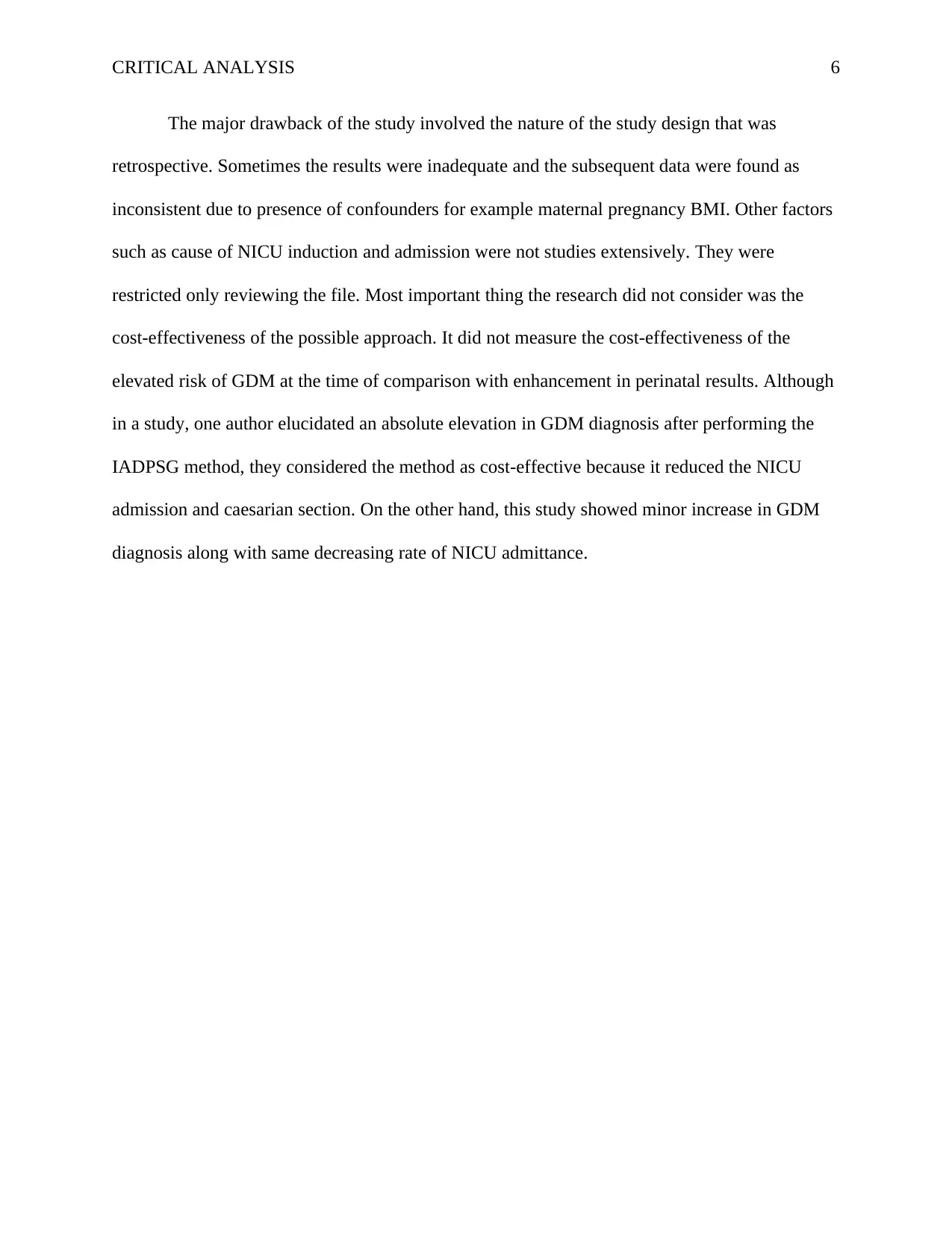
CRITICAL ANALYSIS 6
The major drawback of the study involved the nature of the study design that was
retrospective. Sometimes the results were inadequate and the subsequent data were found as
inconsistent due to presence of confounders for example maternal pregnancy BMI. Other factors
such as cause of NICU induction and admission were not studies extensively. They were
restricted only reviewing the file. Most important thing the research did not consider was the
cost-effectiveness of the possible approach. It did not measure the cost-effectiveness of the
elevated risk of GDM at the time of comparison with enhancement in perinatal results. Although
in a study, one author elucidated an absolute elevation in GDM diagnosis after performing the
IADPSG method, they considered the method as cost-effective because it reduced the NICU
admission and caesarian section. On the other hand, this study showed minor increase in GDM
diagnosis along with same decreasing rate of NICU admittance.
The major drawback of the study involved the nature of the study design that was
retrospective. Sometimes the results were inadequate and the subsequent data were found as
inconsistent due to presence of confounders for example maternal pregnancy BMI. Other factors
such as cause of NICU induction and admission were not studies extensively. They were
restricted only reviewing the file. Most important thing the research did not consider was the
cost-effectiveness of the possible approach. It did not measure the cost-effectiveness of the
elevated risk of GDM at the time of comparison with enhancement in perinatal results. Although
in a study, one author elucidated an absolute elevation in GDM diagnosis after performing the
IADPSG method, they considered the method as cost-effective because it reduced the NICU
admission and caesarian section. On the other hand, this study showed minor increase in GDM
diagnosis along with same decreasing rate of NICU admittance.
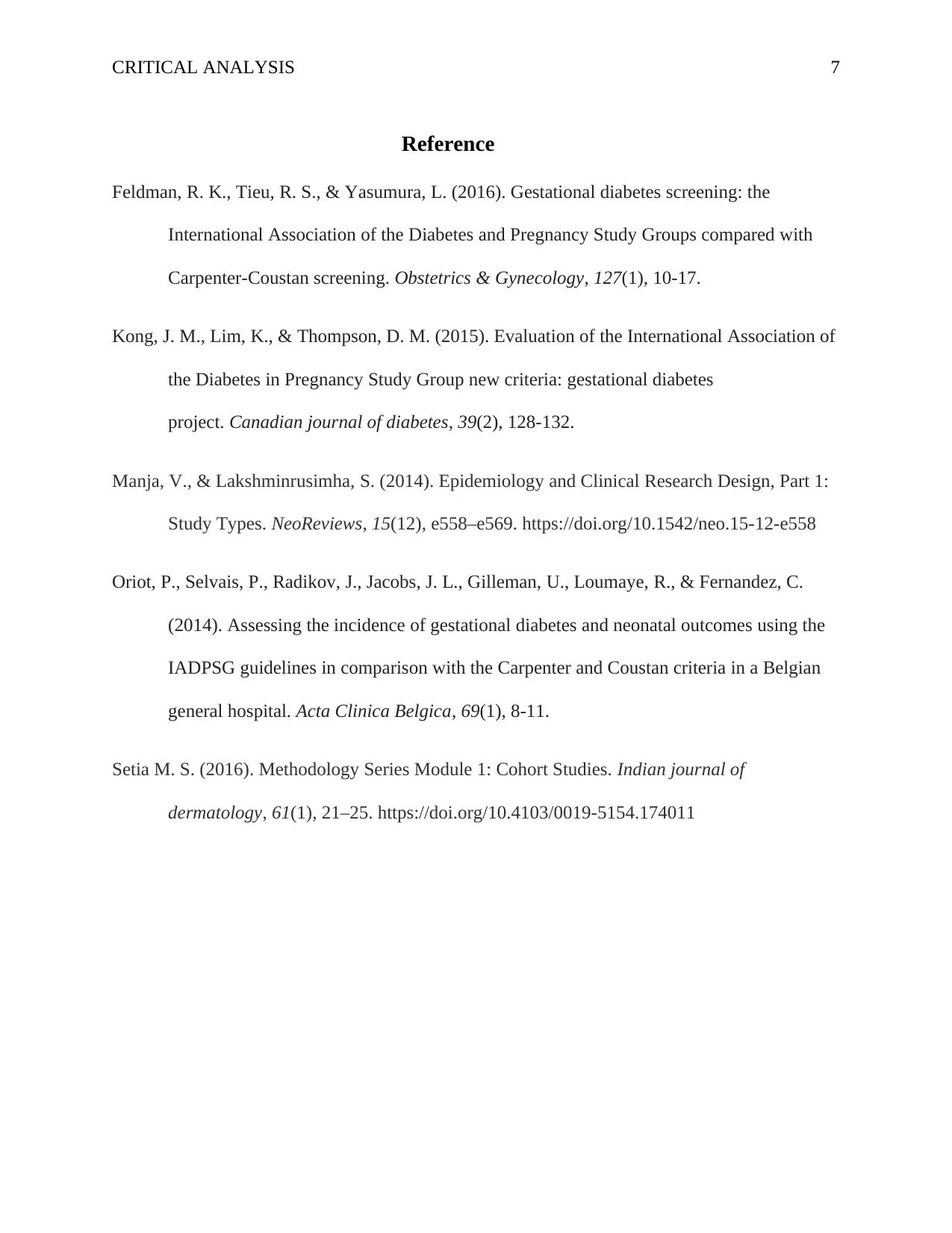
CRITICAL ANALYSIS 7
Reference
Feldman, R. K., Tieu, R. S., & Yasumura, L. (2016). Gestational diabetes screening: the
International Association of the Diabetes and Pregnancy Study Groups compared with
Carpenter-Coustan screening. Obstetrics & Gynecology, 127(1), 10-17.
Kong, J. M., Lim, K., & Thompson, D. M. (2015). Evaluation of the International Association of
the Diabetes in Pregnancy Study Group new criteria: gestational diabetes
project. Canadian journal of diabetes, 39(2), 128-132.
Manja, V., & Lakshminrusimha, S. (2014). Epidemiology and Clinical Research Design, Part 1:
Study Types. NeoReviews, 15(12), e558–e569. https://doi.org/10.1542/neo.15-12-e558
Oriot, P., Selvais, P., Radikov, J., Jacobs, J. L., Gilleman, U., Loumaye, R., & Fernandez, C.
(2014). Assessing the incidence of gestational diabetes and neonatal outcomes using the
IADPSG guidelines in comparison with the Carpenter and Coustan criteria in a Belgian
general hospital. Acta Clinica Belgica, 69(1), 8-11.
Setia M. S. (2016). Methodology Series Module 1: Cohort Studies. Indian journal of
dermatology, 61(1), 21–25. https://doi.org/10.4103/0019-5154.174011
Reference
Feldman, R. K., Tieu, R. S., & Yasumura, L. (2016). Gestational diabetes screening: the
International Association of the Diabetes and Pregnancy Study Groups compared with
Carpenter-Coustan screening. Obstetrics & Gynecology, 127(1), 10-17.
Kong, J. M., Lim, K., & Thompson, D. M. (2015). Evaluation of the International Association of
the Diabetes in Pregnancy Study Group new criteria: gestational diabetes
project. Canadian journal of diabetes, 39(2), 128-132.
Manja, V., & Lakshminrusimha, S. (2014). Epidemiology and Clinical Research Design, Part 1:
Study Types. NeoReviews, 15(12), e558–e569. https://doi.org/10.1542/neo.15-12-e558
Oriot, P., Selvais, P., Radikov, J., Jacobs, J. L., Gilleman, U., Loumaye, R., & Fernandez, C.
(2014). Assessing the incidence of gestational diabetes and neonatal outcomes using the
IADPSG guidelines in comparison with the Carpenter and Coustan criteria in a Belgian
general hospital. Acta Clinica Belgica, 69(1), 8-11.
Setia M. S. (2016). Methodology Series Module 1: Cohort Studies. Indian journal of
dermatology, 61(1), 21–25. https://doi.org/10.4103/0019-5154.174011
1 out of 7
Your All-in-One AI-Powered Toolkit for Academic Success.
+13062052269
info@desklib.com
Available 24*7 on WhatsApp / Email
![[object Object]](/_next/static/media/star-bottom.7253800d.svg)
Unlock your academic potential
© 2024 | Zucol Services PVT LTD | All rights reserved.